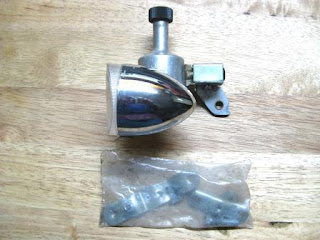I'm selling a couple of things on eBay. So, naturally, I did a little "shopping." In addition to bike items, I like to look for books, music and vintage brooches and other accessories. Ebay is actually quite a good source for the latter: When someone cleans out an attic in Iowa or goes through Aunt Hattie's estate in North Carolina, all kinds of interesting things can turn up!
Anyway, it almost goes without saying that eBay is one of the first places you check if you're looking for discontinued bike parts. And, sure enough, something I rode about fifteen years ago and hadn't thought about in about ten appeared:
The hub is a Nuke Proof, which was made during the 1990's. That was the time when it seemed that every mountain bike bum who was still living with his parents so he could have access to his father's lathe and drill press was making what an old riding partner used to call ELS--Expensive Lightweight Shit.
For a short time, I had Nuke Proof hubs. Two pairs, in fact.
The bodies were made of carbon-fiber weave, and the aluminum flanges were apparently bonded to them. With what, I still haven't found out.
Whatever it was, it wasn't very strong or suitable for the purpose. On three of my four of my Nuke Proof hubs, the flanges separated from the shells and collapsed inward toward the center of the axle.
From what I understand, this wasn't an unusual occurence. In fact, I know a couple of cyclists to whom the same thing happened.
Nuke Proof replaced my hubs. Or so they said. To this day, I think they simply Super-Glued them back together. About a week after I got my wheels back, the rear one on my road bike collapsed again. They didn't want to replace those hubs again. But Mike Rodriguez, who owned Open Road Cycles in Brooklyn, was one of NP's better customers. He got yet another set of new NP hubs. And he let me take a pair each of Dura Ace and XT hubs, plus some other parts, in exchange for those hubs. I don't know what he did with them.
Apparently, Nuke Proof is still in business. To be fair, they made other parts, and for a time they were also making frames, or at least having them made to their specs. As far as I know, those products held up better than those hubs I, and a lot of other cyclists, suffered with.
I never heard of anyone getting hurt from mishaps from Nuke Proof hubs. That might be the reason NP is still in business: If nobody got hurt, they probably didn't have any lawsuits. Still, those hubs must have cost them a lot in warranty claims!
Those hubs are easily the worst bike hubs--and one of the worst bike parts--I ever had.
Tell me about some of the ELS (with the emphasis on the "S") you've ridden, dear readers.
Anyway, it almost goes without saying that eBay is one of the first places you check if you're looking for discontinued bike parts. And, sure enough, something I rode about fifteen years ago and hadn't thought about in about ten appeared:
The hub is a Nuke Proof, which was made during the 1990's. That was the time when it seemed that every mountain bike bum who was still living with his parents so he could have access to his father's lathe and drill press was making what an old riding partner used to call ELS--Expensive Lightweight Shit.
For a short time, I had Nuke Proof hubs. Two pairs, in fact.
The bodies were made of carbon-fiber weave, and the aluminum flanges were apparently bonded to them. With what, I still haven't found out.
Whatever it was, it wasn't very strong or suitable for the purpose. On three of my four of my Nuke Proof hubs, the flanges separated from the shells and collapsed inward toward the center of the axle.
From what I understand, this wasn't an unusual occurence. In fact, I know a couple of cyclists to whom the same thing happened.
Nuke Proof replaced my hubs. Or so they said. To this day, I think they simply Super-Glued them back together. About a week after I got my wheels back, the rear one on my road bike collapsed again. They didn't want to replace those hubs again. But Mike Rodriguez, who owned Open Road Cycles in Brooklyn, was one of NP's better customers. He got yet another set of new NP hubs. And he let me take a pair each of Dura Ace and XT hubs, plus some other parts, in exchange for those hubs. I don't know what he did with them.
Apparently, Nuke Proof is still in business. To be fair, they made other parts, and for a time they were also making frames, or at least having them made to their specs. As far as I know, those products held up better than those hubs I, and a lot of other cyclists, suffered with.
I never heard of anyone getting hurt from mishaps from Nuke Proof hubs. That might be the reason NP is still in business: If nobody got hurt, they probably didn't have any lawsuits. Still, those hubs must have cost them a lot in warranty claims!
Those hubs are easily the worst bike hubs--and one of the worst bike parts--I ever had.
Tell me about some of the ELS (with the emphasis on the "S") you've ridden, dear readers.







